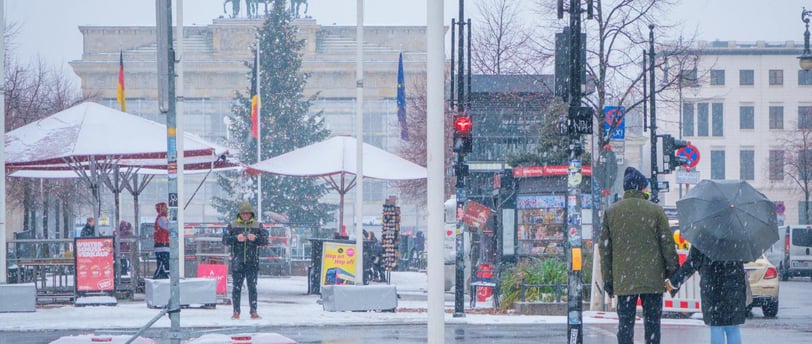Add your promotional text...
European Gas Markets: Stability Amid Challenges – A Winter Analysis
Synopsis: European gas markets have demonstrated resilience this winter, with prices stabilizing below €45/MWh due to steady Russian supplies and robust storage levels. However, challenges such as rising withdrawals, colder weather, and fluctuating demand point to a dynamic energy landscape.
COMMODITIES
By Ekta Mani
12/13/20243 min read


Navigating the European Gas Landscape
As Europe faces another winter with lingering uncertainties over energy supplies, the natural gas market is showing unexpected signs of stability. According to a recent analysis by UBS, the risk premium for European gas has decreased significantly, with Dutch TTF futures—the benchmark for European gas prices dropping below €45/MWh. This marks a decline from earlier winter highs of €49/MWh, signaling improved market confidence despite underlying challenges.
While concerns over Russian gas exports persist, Europe’s energy infrastructure has proven resilient, setting the stage for a dynamic yet stable winter season.
Key Market Trends: Stability Despite Uncertainties
1. Falling Gas Prices
The decline in TTF futures to levels between €40 and €45/MWh reflects a reduction in market risk. Analysts credit this drop to consistent Russian gas supplies, even amid geopolitical tensions and contractual disputes.
2. Gas Storage Levels Remain Strong
European gas storage is currently at 81% capacity (84 bcm) as of December 10, aligning with the five-year average. Although this figure is 10% lower than the same period in 2023, it represents a strong buffer for the winter.
3. Higher Net Withdrawals
The rate of gas withdrawals has outpaced both last year’s and the five-year average due to colder temperatures and reduced LNG imports. Projections suggest storage levels could end the winter at low-40% capacity, which is 15% below this year’s levels but still 8% above the five-year average.
Demand Dynamics: Weather Drives Consumption
1. Rising Overall Demand
In November, European gas demand increased by 3% year-over-year to 35 bcm, primarily driven by colder weather. However, demand remained 16% below the 2017-2021 average, reflecting ongoing efficiency improvements and energy conservation measures.
2. Power Sector Demand
The power sector saw a notable rise in gas usage as wind generation dipped and temperatures fell. This trend highlights the dependence on gas as a backup energy source during periods of reduced renewable energy production.
3. Industrial Demand Recovery
Industrial demand in the EU’s top five gas-consuming countries rose by 15% month-over-month, signaling a short-term recovery. However, it remained below the levels seen in 2022 and the three-year average, reflecting ongoing challenges in energy-intensive industries.
Supply Insights: Mixed Trends Across Sources
1. Stable Piped Gas Imports
In November, Europe imported 16.3 bcm of piped gas, a figure largely unchanged both month-over-month and year-over-year. This consistency has helped ease concerns about potential supply disruptions.
2. Norwegian Gas Supplies
Norwegian gas exports remained steady from October but saw a year-over-year decline due to unplanned outages. As a key supplier to Europe, Norway’s production levels will be critical in meeting winter demand.
3. Russian Gas Dynamics
Russian gas imports fell slightly, dropping by 5% month-over-month (0.1 bcm). This decline is linked to a contractual dispute between OMV and Gazprom. However, other import routes remained stable, with a marginal reduction of 1% month-over-month to 3.9 bcm.
Storage Projections: Managing Winter Demand
While current storage levels are robust, the increased rate of withdrawals suggests a challenging end to the winter season. The colder temperatures and reduced LNG imports could leave storage at low-40% capacity, a significant drop compared to last year but still above historical averages.
Challenges and Opportunities Ahead
Challenges:
Geopolitical Risks: Continued uncertainty over Russian piped gas exports due to geopolitical tensions and contractual disputes.
Weather Volatility: Colder-than-expected weather could accelerate withdrawals, straining storage levels.
LNG Import Slowdown: Reduced LNG imports due to global competition and logistical constraints.
Opportunities:
Resilient Infrastructure: Strong storage management and diversified import sources provide a buffer against potential disruptions.
Demand Adaptability: Energy efficiency measures and demand management strategies continue to offset consumption spikes.
Market Stabilization: Falling prices and consistent supply are helping to restore market confidence, reducing the risk premium for gas.
A Resilient but Watchful Market
The European gas market has entered the winter season with a mix of stability and caution. Falling TTF futures and robust storage levels have bolstered market confidence, but challenges such as colder weather, rising withdrawals, and geopolitical uncertainties underscore the need for vigilance.
As Europe navigates this dynamic landscape, its ability to adapt through efficient energy management, diversified supply chains, and robust infrastructure will be critical in maintaining stability and preparing for the future. While risks remain, the current outlook suggests a cautiously optimistic path forward for Europe’s energy markets.
